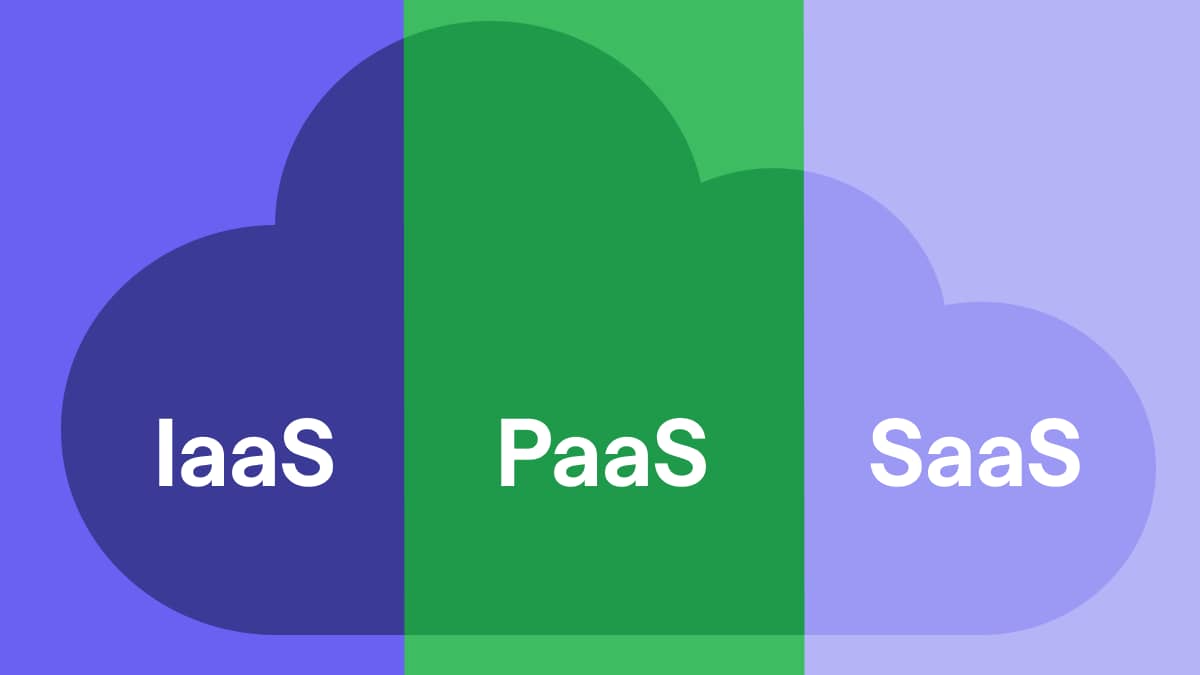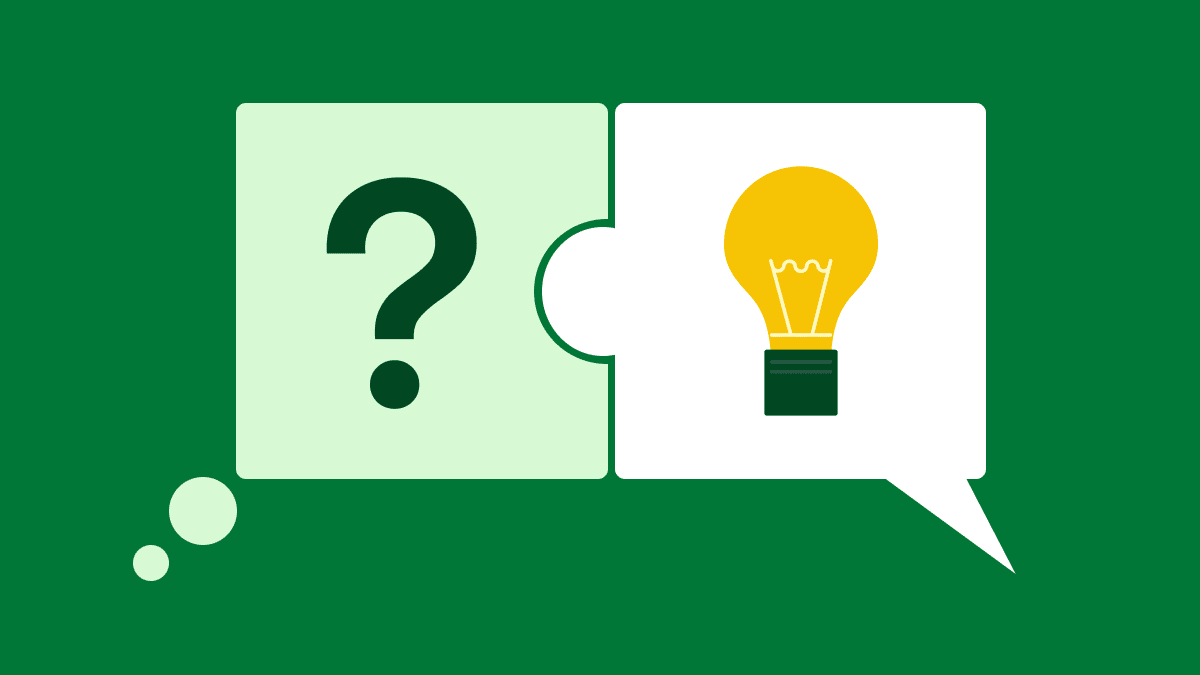The software as a service (SaaS) market requires a specific approach to attract leads and nurture them into loyal customers.
If you’re just getting started in this competitive and deeply technological space, you might feel like you’re in over your head. To be successful, you need to understand the unique sales process, strategies and challenges of SaaS sales.
In this article, you’ll learn all you need to know about sales in the SaaS field. We’ll explain SaaS sales, meaning what it is and what the sales process looks like. We’ll also provide strategies to help boost conversions.
What is SaaS sales?
Software as a service refers to web-based software accessed and managed via the internet. SaaS vendors host their software on the cloud, and customers can use it on a subscription basis. SaaS sales is the process of selling this software.
Examples of SaaS apps include:
Customer relationship management (CRM) platforms such as Pipedrive
Office workspace tools (including the Google Suite)
Creative apps (such as Adobe’s Creative Cloud suite)
Researching SaaS sales examples can help new sales reps understand how successful deals are structured, including how features are positioned and pain points are addressed.
SaaS sales reps are responsible for finding prospective customers, understanding their needs and demonstrating how their product solves their problems.
Typically, sales professionals in the SaaS industry work closely with customer success and marketing teams to nurture relationships and ensure customer satisfaction. The exact process depends on the product, target audience and whether the brand sells to individual customers (B2C) or enterprise clients (B2B).
Key takeaways from this SaaS sales article
What makes software as a service sales different: Unlike other industries, SaaS focuses on recurring revenue and customer lifetime value. Sales reps must prioritize post-sales relationships and stay updated on product changes.
SaaS sales process and models: Choose between a low-touch self-service model for simpler products and a high-touch enterprise model for complex, high-priced software. Effective demos and ongoing customer support are crucial.
How do SaaS sales differ from other industries?
The SaaS industry is unique. With cloud- and subscription-based services, SaaS sales reps need targeted strategies to convince customers to make a purchase.
Here are a few key things that differentiate SaaS sales from other industries:
Subscription-based models. Where other industries focus on one-time sales, SaaS relies on monthly or yearly subscriptions. For this reason, monthly recurring revenue (MRR) is one of the most important metrics for SaaS companies to track.
Emphasis on customer relationships and after-sales success. SaaS sales teams must prioritize post-sales relationships, ensuring clients achieve their desired outcomes and renew their subscriptions. This relationship focus is why SaaS sales reps typically use a solution-selling methodology.
Importance of onboarding and free trials. The SaaS industry requires a great new-customer onboarding experience to maintain positive customer relationships. The better the onboarding, the more likely a customer is to stick with a company and get the most out of your product.
Constant iterations and updates. SaaS products are often under continuous development. The product teams constantly add new features and fix glitches. Sales reps must stay up-to-date on product changes to sell more effectively.
Focus on customer lifetime value (CLTV). In industries that focus on one-time sales, CLTV isn’t that important. For SaaS, it’s vital. With a unified approach to product development, customer support, sales and marketing, companies can retain customers for decades, causing CLTV to skyrocket.
Understanding the SaaS sales process
At a glance, the SaaS sales cycle looks similar to other industries. Sales reps need to find and qualify leads and then convince them to purchase their product. However, the unique nature of SaaS products means there are important differences.
The following five-step SaaS sales process template incorporates the most popular SaaS sales methodology and explains each stage in detail.
1. Prospecting and lead generation
The first step in any sales process is attracting potential customers, known as sales leads. These are people who have expressed interest in your software but aren’t yet convinced that it’s the right choice for them.
There are two main ways to get leads: inbound lead generation and prospecting.
Inbound lead generation includes methods that help interested customers find your company or product on their own. Examples include content marketing, advertising, social media marketing and referrals.
The goal is to create content that shows your target audience how your product will solve their pain points. By providing value to potential customers from their first interaction, you encourage them to move down the sales funnel.
Outbound prospecting is when sales reps identify leads based on their own research.
For example, a software sales team selling a project management platform might research all the companies in their area that commonly use the software, like product marketing agencies. Once they find the right prospects, sales development representatives (SDRs) can contact them using outreach tactics such as cold calls or cold emails.
Four Steps to Finding the Right Leads Fast
How Pipedrive can help
Pipedrive’s Prospector feature can streamline outbound prospecting. Based on your ideal customer persona, it searches a database of over 400 million business profiles and 10 million companies to provide your team with data and contact info for your most likely prospects.
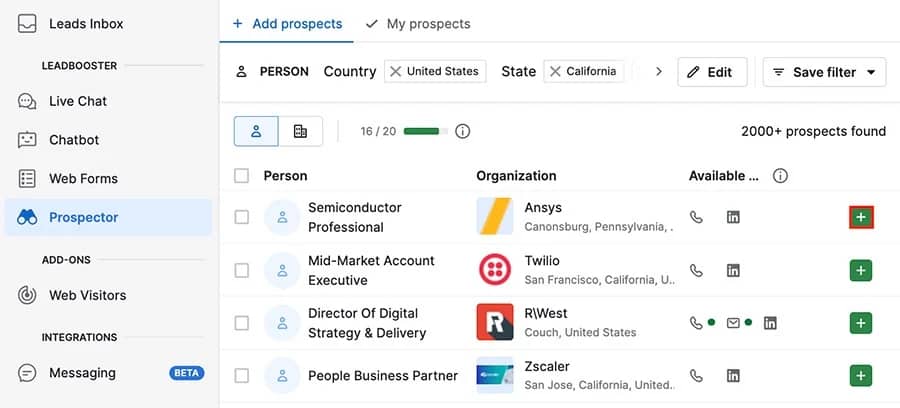
2. Lead qualification
The next step in the SaaS sales process is sales qualification. Not all leads are good fits for your company. Lead qualification helps you determine which ones fit your SaaS product and are sales-ready.
Often, organizations qualify leads according to the BANT framework, which stands for budget, authority, needs and timing.
Some questions you might ask include:
Do they have the required budget for your product?
Does your product meet their needs and solve their pain points?
Do you have access to decision-makers at their organization?
What is your prospect’s timeline for buying?
If a prospect meets at least three of these criteria, they’re likely a good fit for your company.
Depending on how specialized your product is, lead qualification might take more groundwork. For example, some organizations also perform needs analysis. At this stage, the sales team interacts with their prospects to fully understand their requirements, challenges and goals.
Usually, a SaaS sales rep conducts a discovery call with their prospect. During the phone call, they ask questions about their current processes and pain points. With this information, the rep can create a tailored sales pitch and demonstrate what their product can do.
How Pipedrive can helpPipedrive’s Leads Inbox provides a centralized hub for collecting and managing incoming leads before they enter the sales pipeline.
SaaS sales teams can customize leads with labels such as “cold”, “warm” and “hot” to tailor communication and prioritize leads most likely to convert.
Here’s an example of how the feature looks in action:
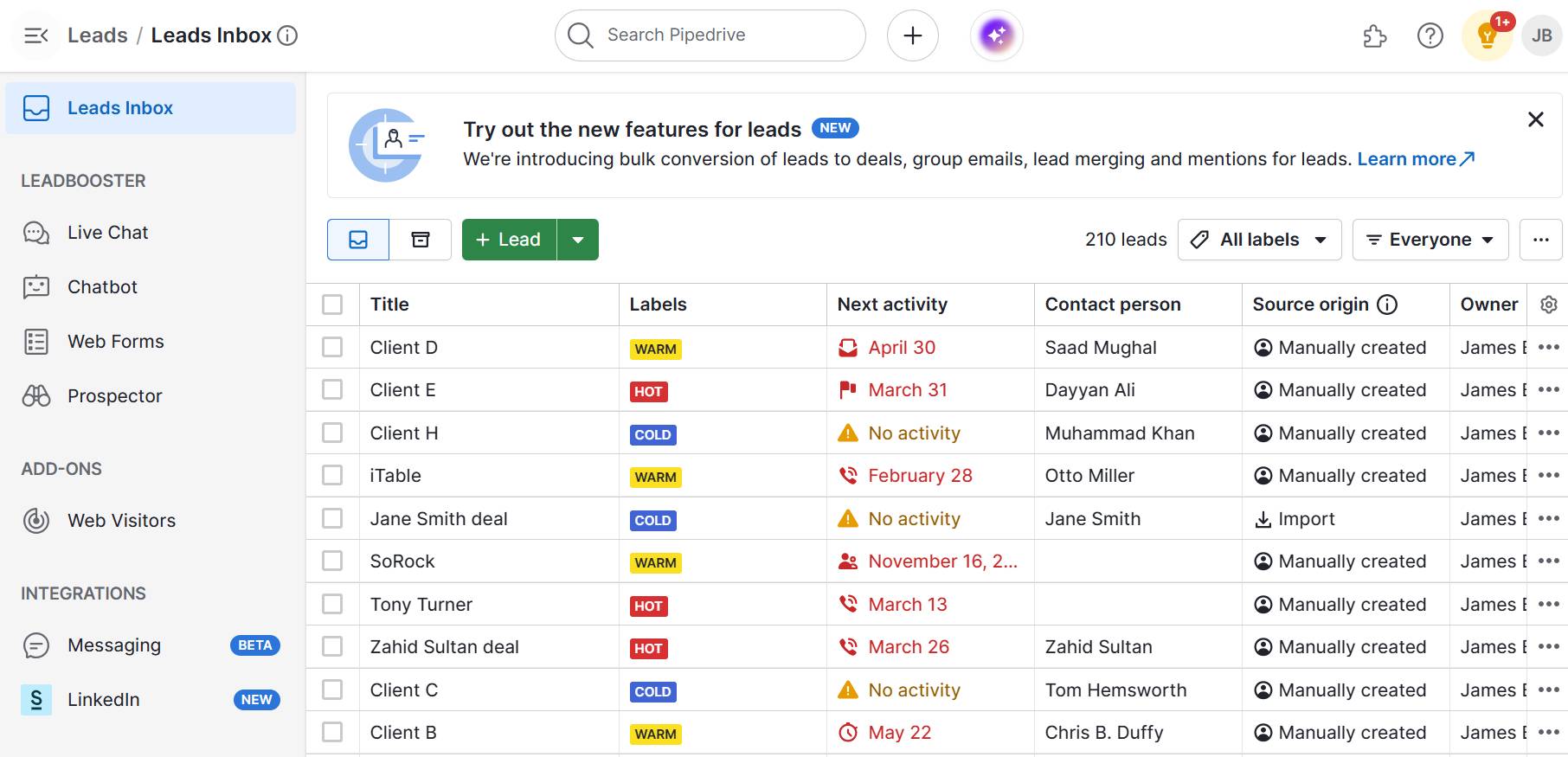
3. Product demonstration
Once you understand a prospect’s needs, it’s time to provide a detailed demo of your product’s features and functionality. Specifically, you want to show the prospect how it can help solve their problems.
There are two main ways SaaS companies demonstrate their products:
Live demonstrations. Salespeople meet with prospects either in person or virtually. For example, they might schedule a screen-sharing session to walk a prospect through the software, highlighting key features they find important.
Free trial periods. Many SaaS companies offer free trials so potential customers can get a feel for the software before buying. This strategy is effective because it allows customers to navigate the sales funnel. However, it’s often most effective when paired with great customer support.
Providing the perfect sales demo takes practice. Each sales demo should target a single customer and leave room for questions, allowing you to showcase the product’s features in the context of the prospect’s pain points.
How Pipedrive can help
SaaS sales reps can use Pipedrive’s scheduling tools and app integrations to book live demos directly from the CRM. Pipedrive can also automate follow-ups to ensure prospects and active deals stay engaged.
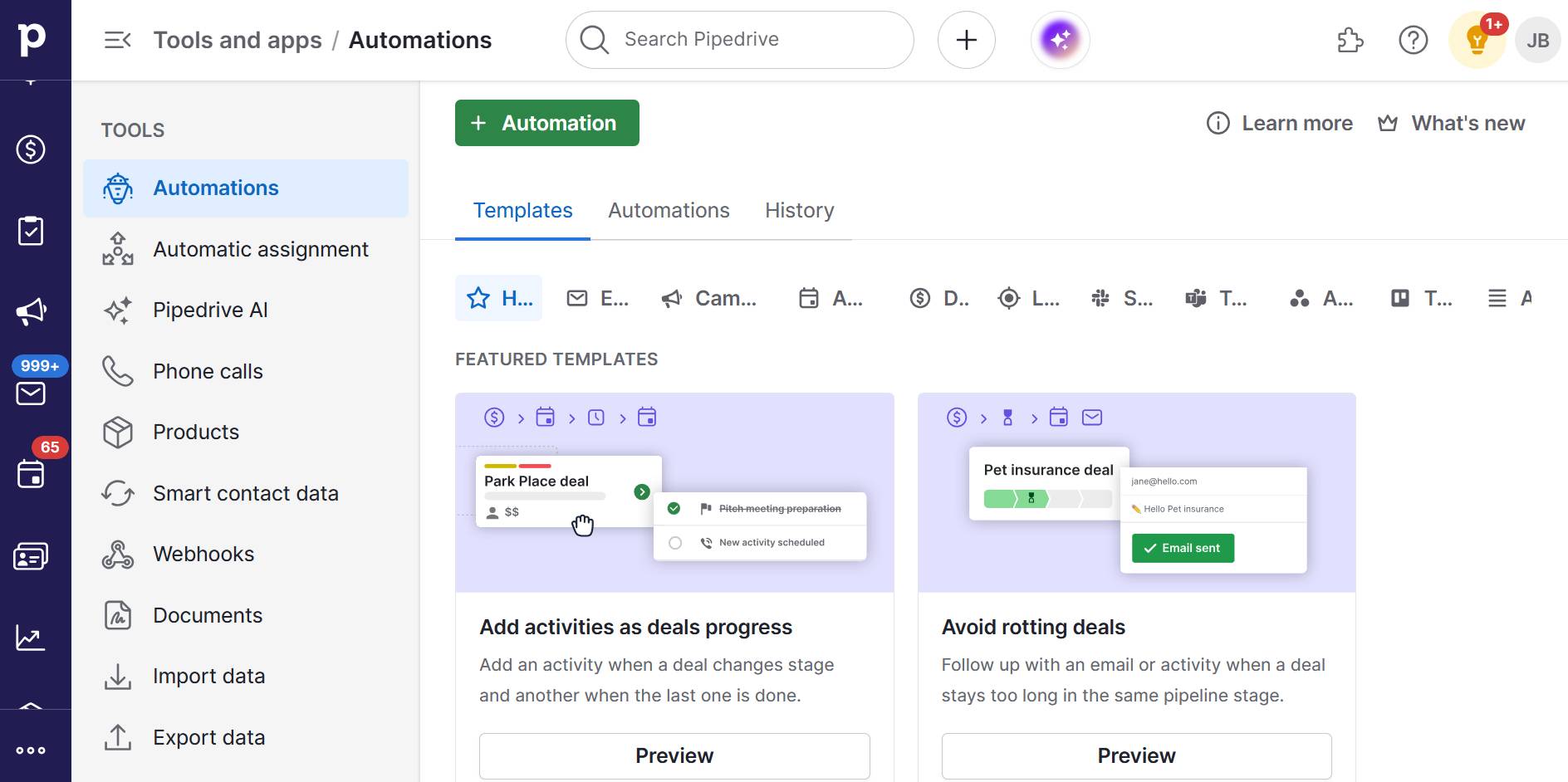
4. Closing deals
If the lead wants to move forward, it’s time to close the deal. This part of the sales process can differ depending on your product and target audience.
For B2C sales, customers will often take a free trial and then subscribe to the product on their own. Since they only need one subscription, the process is relatively straightforward.
However, the process can be much more complicated for B2B SaaS sales. In these cases, the sales team will usually prepare a sales proposal that outlines the pricing and terms and conditions of the subscription. The sales team then negotiates with the customer to find a mutually agreeable solution.
For example, the sales representative may present different pricing tiers and discuss contract length options based on the prospect’s budget and requirements.
The bigger the company, the longer this step will take. The sales team might have to convince multiple people or provide additional services, like large-scale onboarding or dedicated customer service agents.
The sales team will then secure the customer’s commitment. This final step involves finalizing the agreement, getting the necessary signatures and processing the payment.
How Pipedrive can help
Pipedrive’s Smart Docs can help seal the deal by centralizing the documentation process. The feature lets SaaS sales teams request signatures, get status updates and manage documents in one place.
5. After-sales service
In the SaaS industry, providing ongoing support after a sale is crucial. After closing a sale, many SaaS companies provide onboarding services. During this process, the company trains the customer to use their product effectively.
Training might involve:
Personalized onboarding sessions
Access to training materials, such as an in-depth knowledge base
Assistance with data migration from another service
Once the customer is actively using the SaaS product, the sales team might collaborate with customer success to reduce the churn rate. For example, they might make regular check-ins, address concerns and provide guidance to maximize the software’s value.
The sales team also plays a role in helping customers renew their subscriptions when the initial term is coming to an end. They might contact the customers, collect feedback and discuss options for renewing the current subscription.
How Pipedrive can help
Pipedrive’s sales reporting software makes it easy to monitor customer satisfaction, flag at-risk accounts and plan follow-up strategies. The feature presents key sales metrics in easy-to-view charts and tables and allows salespeople to generate real-time reports using custom fields and filters.
The two main SaaS sales models
There are two main sales models for SaaS companies: low-touch self-service and high-touch enterprise sales. The most suitable approach depends on the price of your product and your ideal customer.
While some of the bigger SaaS companies go for something in between, we recommend focusing on a single approach if you’re new to the scene. Read on for a quick explanation of each model to help you choose.
Note: You may have heard the term “transactional sales” in relation to SaaS selling. Transactional sales is another sales model that falls between the two mentioned here. It involves a short sales cycle and providing customers with quick onboarding, as well as a higher sales price, interactions with the company and some level of support.
Customer self-service
In a self-service sales model, customers discover, evaluate and purchase your product independently. The sales experience is mostly automated, and pricing, features and product information are available on your company website.
This sales model often includes support resources such as knowledge bases, FAQs and tutorials to help customers make a decision. In addition to this, customer support agents might be available to answer questions and resolve issues.
When to use a self-serve model
A self-serve sales model is best for low-cost products that are easy to learn and use. Customers need to understand whether or not your product fits their needs without personalized help from a sales rep.
Likewise, self-service models are better suited to target markets of either small companies or individual users. Larger companies will have more complex needs and more user seats, meaning a longer sales cycle and detailed negotiations.
Download our customer journey map template
Enterprise sales
The enterprise sales model focuses on selling to large companies with complex needs. It usually involves a more personalized and consultative selling approach. The sales process is also longer and often involves multiple decision-makers and stakeholders.
Under the enterprise sales model, companies typically have dedicated account executives or sales managers who engage with prospective customers. To guide these prospects through the SaaS sales funnel, they’ll conduct detailed needs analyses, provide custom demos and address specific needs and concerns.
Another key difference between enterprise sales and self-service is pricing. Under enterprise sales, pricing is based on the number of users, customized features and additional services. For this reason, it’s often not set in stone; instead, agreements are negotiated for each customer.
When to use an enterprise sales model
This sales model is most effective for software that is more specialized, complex and sold at a higher price. The more personalized approach helps convince prospects to make a purchase. It’s also necessary for them to get the most out of the product in the long term.
An enterprise sales model is also more effective for a target market of medium to large-sized companies where self-service isn’t an option.
6 high-level tips for boosting SaaS sales
If you’re new to SaaS sales, it’s crucial to develop a sales process that can scale with your business. Here are six key tips that will help streamline your sales efforts:
1. Know your product
When selling to new customers, you need to understand your product inside and out. Only then can you effectively communicate its value proposition, features and benefits.
The better you know your product, the more you’ll be able to:
Generate credibility and trust. In-depth product knowledge helps you answer questions confidently and address concerns. Customers will see this and see you as a credible source of information.
Tailor SaaS solutions to each prospect. Knowing your product will help you identify the most relevant solutions and features to highlight for each customer. You can then explain key capabilities and use cases that address each customer’s challenges and goals. You’ll also be able to find cross-sell and upsell opportunities.
Differentiate your products from competitors. The better you know your products, the more you can highlight their unique selling points. When a customer has an objection or mentions a competitor, you can easily position your product as the superior choice.
Many organizations provide sales training to keep their salesforce updated on products and provide reps with talking points. Salespeople can also study the specs and test the product to gain a working knowledge for reference.
2. Provide a transparent pricing model
Transparent pricing is crucial for several reasons. Firstly, when you provide a clear pricing model upfront, you build trust. Unclear pricing can imply hidden costs down the line, which can cause some customers to second-guess your offerings.
Secondly, transparent pricing helps align customer expectations with your offerings. It gives them a clear understanding of how much they’ll pay and what features they’ll get with their subscription.
Finally, a clear pricing model minimizes barriers to entry, which is especially important for a self-service sales model. When pricing is clearly communicated, customers can easily tell how affordable and feasible the product is, leading to a greater likelihood of conversion.
3. Monitor key SaaS sales metrics
Understanding and tracking key sales metrics can help you develop benchmarks and optimize your sales process. Here are three crucial examples for the SaaS industry.
Customer acquisition cost (CAC) is the amount of money it costs you, on average, to acquire a new customer. It includes all expenses from marketing, advertising and sales activities. To calculate CAC, you divide the total expenditure by the number of new customers.
For example, say you acquired 10 new customers in July and spent $1,000 on marketing and sales activities. Your customer acquisition cost is $1,000/10 = $100.
Customer lifetime value (CLTV) refers to how much revenue you can expect to generate from a single customer over their entire relationship with you. For SaaS businesses, CLTV takes into account the expected retention period and the cost of their subscription.
To calculate CLTV, you must multiply the average subscription value by the average customer lifespan. Say most customers stick with you for five years on your mid-tier plan, which costs $500 per year, your CLTV will be $500 x 5 = $2,500.
Bonus tip: By comparing your CLTV with your CAC, you can determine your efforts’ return on investment (ROI). In this case, the ROI will be $2,500 – $100, or $2,400.
Monthly recurring revenue (MRR), like annual recurring revenue (ARR), estimates the predictable revenue you can expect from your subscription-based customers. To calculate MRR, you need to multiply your number of active users by the average monthly revenue generated by each customer.
For example, say your monthly average revenue per customer is $50, and you have 1,000 active users. Your MRR will be $50 x 1,000 = $50,000.
4. Offer effective trial periods that convince prospects to invest
In the SaaS industry, it’s common for prospective customers to take a free trial but not purchase the paid plan. To address this challenge, SaaS companies must provide more effective trial periods followed by paid plans offering excellent value.
One strategy is to provide free trials with limited but meaningful access. This way, potential customers can get a feel for the software and access the core features without overwhelming them with too many options.
Likewise, providing personalized assistance during the free trial is important. The better a prospect gets to know your software, the more likely they’ll subscribe. For example, you could provide live chat support, onboarding calls and extensive user resources.
5. Provide personalized demos that convert leads into customers
To convince a prospect to buy your software, you must demonstrate its value. The best way to do this is with an interactive, personalized and impactful product demo.
Here are some tips to get the most out of your product demos:
Tailor the content to your prospect. Take time to research and understand your prospects’ needs so that you can position your product optimally. Collect case studies and SaaS sales examples illustrating how your software has helped similar customers.
Address key concerns. If you try to avoid concerns and objections, you’ll likely lose the sale. Instead, start the demo by addressing any key problems your prospect mentioned beforehand.
Provide time for questions. If you haven’t had a discovery call with your prospect, try incorporating some discovery questions to get to know them better. Likewise, leave time at the end of the demo to address any questions they have in return.
6. Use CRM software to nurture your customers
As mentioned above, customer relationship management software is crucial for managing customer data, prioritizing leads and optimizing sales activities.
Powerful CRM solutions like Pipedrive offer a suite of products and features that help you drive sales and maintain SaaS sales performance. These features include:
A centralized customer database. With Pipedrive, you can store and manage all existing customer data under one roof. Track and manage contact details, communication history and other notes, then use this information to make data-driven decisions.
Sales pipeline management. CRM systems like Pipedrive help you track leads and deals at various stages. You can also assign tasks, use workflow automations and set follow-up reminders, ensuring that no opportunities slip through the gaps.
Sales performance analysis. CRM solutions provide valuable insights and analytics on sales performance and other key metrics. For example, you can use Pipedrive to generate insights and reports and get visibility into conversion rates, recurring revenue and other key performance indicators (KPI).
Final thoughts
Selling software can be a challenge, and this is especially true when selling SaaS products. Between customer preferences, technology and increasing competition, the SaaS landscape is constantly changing.
Sales reps can use the tips outlined in this guide to build an effective SaaS sales strategy and maintain a competitive advantage.
Pipedrive’s CRM tools streamline customer data management, sales pipeline tracking and performance analysis. These tools help SaaS sales teams nurture leads and boost conversions with a centralized customer database. Try Pipedrive free for 14 days.


